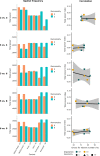Archerfish number discrimination
- PMID: 35001869
- PMCID: PMC8786312
- DOI: 10.7554/eLife.74057
Archerfish number discrimination
Abstract
Debates have arisen as to whether non-human animals actually can learn abstract non-symbolic numerousness or whether they always rely on some continuous physical aspect of the stimuli, covarying with number. Here, we investigated archerfish (Toxotes jaculatrix) non-symbolic numerical discrimination with accurate control for covarying continuous physical stimulus attributes. Archerfish were trained to select one of two groups of black dots (Exp. 1: 3 vs 6 elements; Exp. 2: 2 vs 3 elements); these were controlled for several combinations of physical variables (elements' size, overall area, overall perimeter, density, and sparsity), ensuring that only numerical information was available. Generalization tests with novel numerical comparisons (2 vs 3, 5 vs 8, and 6 vs 9 in Exp. 1; 3 vs 4, 3 vs 6 in Exp. 2) revealed choice for the largest or smallest numerical group according to the relative number that was rewarded at training. None of the continuous physical variables, including spatial frequency, were affecting archerfish performance. Results provide evidence that archerfish spontaneously use abstract relative numerical information for both small and large numbers when only numerical cues are available.
Keywords: archerfish; archerfish (toxotes jaculatrix); neuroscience; number; number discrimination; number sense; numerical cognition; numerical rule.
© 2022, Potrich et al.
Conflict of interest statement
DP, MZ, GV No competing interests declared
Figures












References
Publication types
MeSH terms
Associated data
LinkOut - more resources
Full Text Sources
Other Literature Sources

